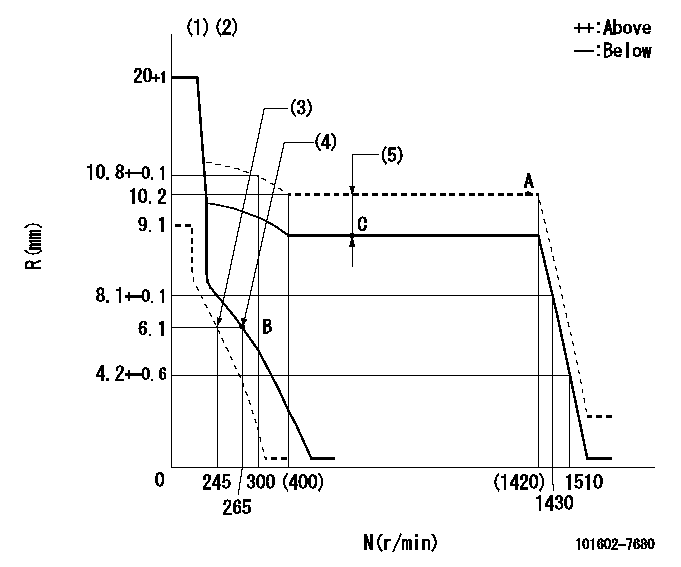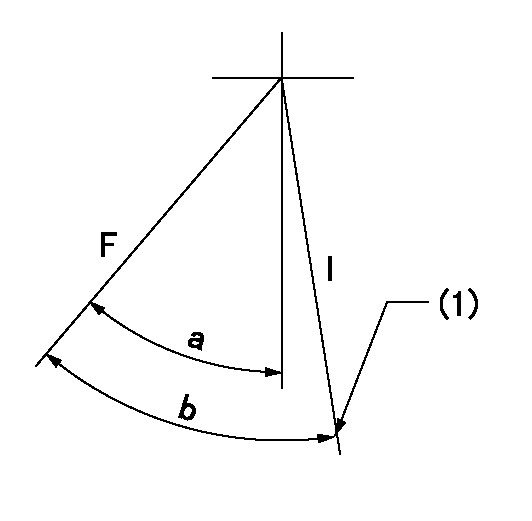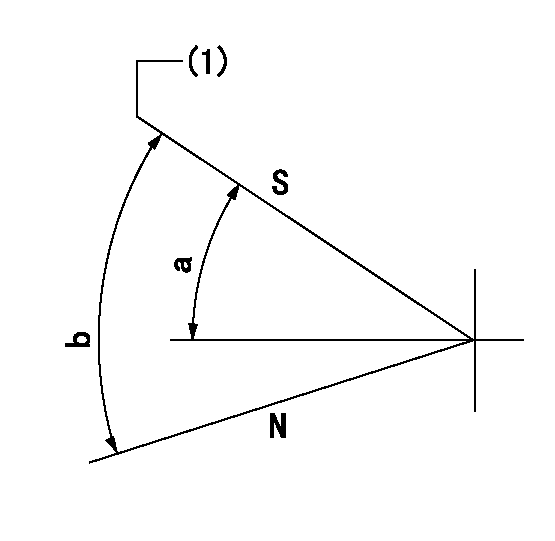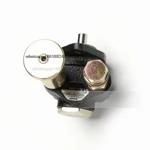Information injection-pump assembly
BOSCH
9 400 614 912
9400614912
ZEXEL
101602-7680
1016027680
ISUZU
1156029150
1156029150

Rating:
Service parts 101602-7680 INJECTION-PUMP ASSEMBLY:
1.
_
5.
AUTOM. ADVANCE MECHANIS
6.
COUPLING PLATE
8.
_
9.
_
11.
Nozzle and Holder
1-15300-240-1
12.
Open Pre:MPa(Kqf/cm2)
22.1{225}
15.
NOZZLE SET
Include in #1:
101602-7680
as INJECTION-PUMP ASSEMBLY
Include in #2:
104740-1592
as _
Cross reference number
BOSCH
9 400 614 912
9400614912
ZEXEL
101602-7680
1016027680
ISUZU
1156029150
1156029150
Zexel num
Bosch num
Firm num
Name
101602-7680
9 400 614 912
1156029150 ISUZU
INJECTION-PUMP ASSEMBLY
6BG1-MTC K 14BF INJECTION PUMP ASSY PE6AD PE
6BG1-MTC K 14BF INJECTION PUMP ASSY PE6AD PE
Calibration Data:
Adjustment conditions
Test oil
1404 Test oil ISO4113 or {SAEJ967d}
1404 Test oil ISO4113 or {SAEJ967d}
Test oil temperature
degC
40
40
45
Nozzle and nozzle holder
105780-8140
Bosch type code
EF8511/9A
Nozzle
105780-0000
Bosch type code
DN12SD12T
Nozzle holder
105780-2080
Bosch type code
EF8511/9
Opening pressure
MPa
17.2
Opening pressure
kgf/cm2
175
Injection pipe
Outer diameter - inner diameter - length (mm) mm 6-2-600
Outer diameter - inner diameter - length (mm) mm 6-2-600
Overflow valve
131424-4920
Overflow valve opening pressure
kPa
127
107
147
Overflow valve opening pressure
kgf/cm2
1.3
1.1
1.5
Tester oil delivery pressure
kPa
157
157
157
Tester oil delivery pressure
kgf/cm2
1.6
1.6
1.6
Direction of rotation (viewed from drive side)
Right R
Right R
Injection timing adjustment
Direction of rotation (viewed from drive side)
Right R
Right R
Injection order
1-5-3-6-
2-4
Pre-stroke
mm
4.4
4.35
4.45
Beginning of injection position
Drive side NO.1
Drive side NO.1
Difference between angles 1
Cal 1-5 deg. 60 59.5 60.5
Cal 1-5 deg. 60 59.5 60.5
Difference between angles 2
Cal 1-3 deg. 120 119.5 120.5
Cal 1-3 deg. 120 119.5 120.5
Difference between angles 3
Cal 1-6 deg. 180 179.5 180.5
Cal 1-6 deg. 180 179.5 180.5
Difference between angles 4
Cyl.1-2 deg. 240 239.5 240.5
Cyl.1-2 deg. 240 239.5 240.5
Difference between angles 5
Cal 1-4 deg. 300 299.5 300.5
Cal 1-4 deg. 300 299.5 300.5
Injection quantity adjustment
Adjusting point
A
Rack position
R1(10.2)
Pump speed
r/min
1350
1350
1350
Average injection quantity
mm3/st.
105.5
103.9
107.1
Max. variation between cylinders
%
0
-2.5
2.5
Basic
*
Fixing the lever
*
Boost pressure
kPa
124
124
Boost pressure
mmHg
930
930
Injection quantity adjustment_02
Adjusting point
B
Rack position
6.1+-0.5
Pump speed
r/min
265
265
265
Average injection quantity
mm3/st.
12
10.7
13.3
Max. variation between cylinders
%
0
-14
14
Fixing the rack
*
Boost pressure
kPa
0
0
0
Boost pressure
mmHg
0
0
0
Boost compensator adjustment
Pump speed
r/min
700
700
700
Rack position
R1-1.6
Boost pressure
kPa
17.3
16
18.6
Boost pressure
mmHg
130
120
140
Boost compensator adjustment_02
Pump speed
r/min
700
700
700
Rack position
R1(10.2)
Boost pressure
kPa
104
90.7
117.3
Boost pressure
mmHg
780
680
880
Test data Ex:
Governor adjustment

N:Pump speed
R:Rack position (mm)
(1)Target notch: K
(2)Tolerance for racks not indicated: +-0.05mm.
(3)Set idle sub-spring
(4)Main spring setting
(5)Boost compensator stroke: BCL
----------
K=15 BCL=1.6+-0.1mm
----------
----------
K=15 BCL=1.6+-0.1mm
----------
Speed control lever angle

F:Full speed
I:Idle
(1)Stopper bolt setting
----------
----------
a=(28deg)+-5deg b=(34deg)+-5deg
----------
----------
a=(28deg)+-5deg b=(34deg)+-5deg
Stop lever angle

N:Pump normal
S:Stop the pump.
(1)Pump speed aa and rack position bb (to be sealed at delivery)
----------
aa=0r/min bb=1-0.2mm
----------
a=32deg+-5deg b=(55deg)
----------
aa=0r/min bb=1-0.2mm
----------
a=32deg+-5deg b=(55deg)
Timing setting

(1)Pump vertical direction
(2)Position of gear mark 'CC' at No 1 cylinder's beginning of injection
(3)B.T.D.C.: aa
(4)-
----------
aa=15deg
----------
a=(100deg)
----------
aa=15deg
----------
a=(100deg)
Information:
Cautions Regarding Battery* Handle Battery Carefully * Never use flames or allow sparks near the battery. The battery releases flammable hydrogen gas and oxygen gas. These gases can be ignited by flames and cause an explosion.* Do not use the battery when the fluid surface is lower than the minimum level. Using a battery with a low electrolyte level can result in an explosion.* Do not short the battery terminals with a tool or other metal object.* When disconnecting battery cables, always remove the cable from the negative (-) terminal first. When reconnecting cables, attach the cable to the positive (+) terminal first.* Charge the battery in a well-ventilated area, with all filling hole plugs removed.* Make sure the cable clamps are securely installed on the battery terminals. A loose cable clamp can cause sparks that may result in explosion.* Before servicing electrical components or conducting electrical welding, set the battery switch to the [Open/OFF] position or disconnect the cable from the negative (-) battery terminal to cut off the electrical current.* Electrolyte (battery fluid) contains dilute sulfuric acid. Careless handling of the battery can lead to the loss of sight and/or burns. Also, do not swallow electrolyte.* Wear protective goggles and rubber gloves when maintaining and inspecting the battery (when adding water, charging, etc.).* If electrolyte is spilled onto the skin or clothes, immediately wash with lots of clean fresh water and thoroughly clean with soap.* If electrolyte gets into eyes, immediately flush with lots of clean fresh water and seek immediate medical attention.* Should you accidentally swallow electrolyte, gargle with plenty of water, then drink lots of water, and seek immediate medical attention.
Response To Abnormalities* If Engine Overheats, Conduct Heating Operation Before Stopping The Engine If the engine overheats, do not stop the engine immediately. Abruptly stopping an overheated engine may cause the coolant temperature to rise, resulting in seizing of the engine. If the engine overheats, operate the engine at low idling speed (cooling temperature), and stop the engine after the coolant temperature lowers sufficiently.Do not add coolant immediately after stopping the engine. Adding coolant to a hot engine may cause damage to the cylinder heads due to sudden change in temperature. Add coolant after the engine cools to room temperature.* If Engine Stops Due To Abnormality, Exercise Caution When Restarting If the engine stops due to an abnormality, do not restart the engine immediately. If the engine stops with an alarm, check and correct the cause of the problem before restarting. Operating the engine without correcting the problem may result in serious engine problems.* If Oil Pressure Drops, Stop Engine Immediately If the engine oil pressure decreases, stop the engine immediately, and inspect the lubrication system. Operating the engine with low oil pressure may cause seizing of the bearings and other parts.* If Fan Belt Breaks, Stop Engine Immediately If the fan belt breaks, stop the engine immediately. Continued operation of the engine without the fan belt causes coolant to change to steam and
Response To Abnormalities* If Engine Overheats, Conduct Heating Operation Before Stopping The Engine If the engine overheats, do not stop the engine immediately. Abruptly stopping an overheated engine may cause the coolant temperature to rise, resulting in seizing of the engine. If the engine overheats, operate the engine at low idling speed (cooling temperature), and stop the engine after the coolant temperature lowers sufficiently.Do not add coolant immediately after stopping the engine. Adding coolant to a hot engine may cause damage to the cylinder heads due to sudden change in temperature. Add coolant after the engine cools to room temperature.* If Engine Stops Due To Abnormality, Exercise Caution When Restarting If the engine stops due to an abnormality, do not restart the engine immediately. If the engine stops with an alarm, check and correct the cause of the problem before restarting. Operating the engine without correcting the problem may result in serious engine problems.* If Oil Pressure Drops, Stop Engine Immediately If the engine oil pressure decreases, stop the engine immediately, and inspect the lubrication system. Operating the engine with low oil pressure may cause seizing of the bearings and other parts.* If Fan Belt Breaks, Stop Engine Immediately If the fan belt breaks, stop the engine immediately. Continued operation of the engine without the fan belt causes coolant to change to steam and
Have questions with 101602-7680?
Group cross 101602-7680 ZEXEL
Isuzu
101602-7680
9 400 614 912
1156029150
INJECTION-PUMP ASSEMBLY
6BG1-MTC
6BG1-MTC
